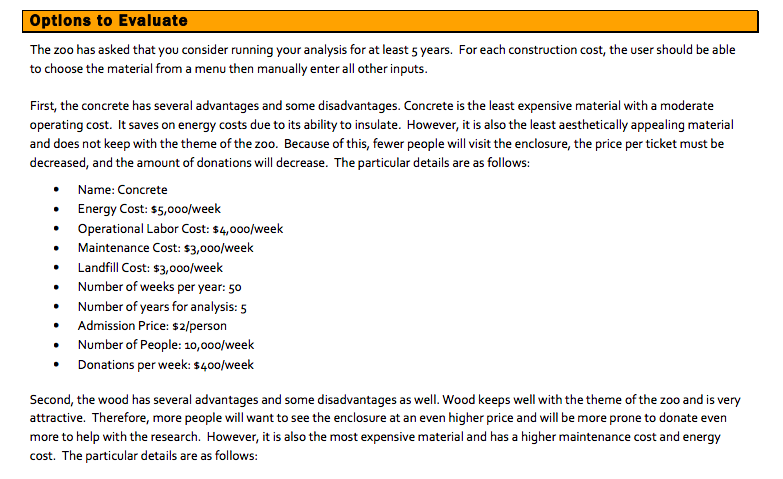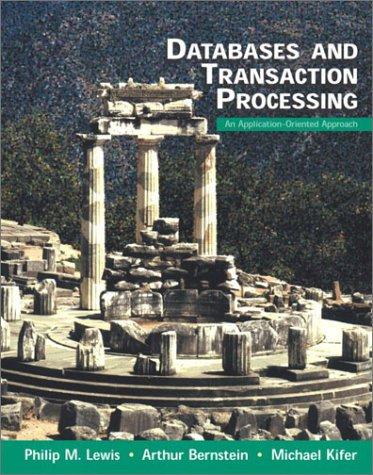Question
clear clc close all %Fixed Cost M = {'Concrete',12, 30, 85000, 900, 4, 4;'Wood',18, 50, 100000, 800, 12, 10; 'Adobe',15,42, 55000, 600, 4, 5}; choice
clear
clc
close all
%Fixed Cost
M = {'Concrete',12, 30, 85000, 900, 4, 4;'Wood',18, 50, 100000, 800, 12, 10; 'Adobe',15,42, 55000, 600, 4, 5};
choice = menu('choose a type of material',M(1:3,1));
choice = {M{choice,1:7}};
SurfaceArea = 3000; %ft^2
Thickness = choice{1,2}/12; %converts to ft
MaterialCost = choice{1,3}; %$/ft^3
MicellaneousMaterial = choice{1,4}; %$
LaborCost = choice{1,5}; %$ /(person week)
Laborers = choice{1,6}; %# of laborers(people)
Weeks = choice{1,7}; %weeks of construction
MCost = Thickness*SurfaceArea*MaterialCost; %Total cost of matieral,$
LCost = LaborCost*Laborers*Weeks; %Total cost of labor,$
FixedCost = MCost + LCost + MicellaneousMaterial; %Fixed cost, $
%Variable Costs and Revenue
%Cost Variables
Energycost = input('Energy Cost:'); %$
Laborcost = input('Labor Cost:'); %$
Landfillcost = input('Land Fill Cost:'); %$
Maintenancecost = input('Maintenance Cost:'); %$
%Revenue Variables
Priceadmission = input('Price admission per person:'); %$
People = input('# of people per week:'); %$
Donations = input('Expected donations per week:'); %$
%Other Variables
OWeeks = input('Operating weeks:'); %Operating weeks per year
Years = input('# of years:'); %Years to operate construction
N = (0:Years); %Years
%Process
TFixedCost = FixedCost; %Fixed cost already calculated
VariableCost = Energycost + Laborcost + Landfillcost + Maintenancecost; %Total cost to operate enclosure per week
TotalCost = TFixedCost + VariableCost * N * OWeeks ; %Cost to operate for # of years
Revenue = ((Priceadmission * People * N) + (Donations * N)) * OWeeks; %Revenue from customers for # of years
Profit = (Revenue - TotalCost) .* N; %Total profit per year
BreakEvenY = TFixedCost ./ (TotalCost - VariableCost); %Breakeven point in years
BreakEvenM = BreakEvenY * 12; %Breakeven in months
MProfit = Profit / BreakEvenM(1,5)
WM = 4.2; %Weeks per month
DonationsBreak = Donations * WM * 4; %$ from donations needed to breakeven in 4 months
%Summary of Results
fprintf('Material: %s \t Operating %0.0f weeks per year will generate per year: \t\t Revenue: $%0.0f \t\t Cost: $%0.0f \t The breakeven time is %0.2f months \t The total profit after %0.0f years is $%1.3e2.',choice{1:1},OWeeks,Revenue(1,2),TotalCost(1,2),BreakEvenM(1,Years),Years,Profit(1,Years))
fprintf(' It will take a one-time donation of $%5.2f to breakeven in four months.',DonationsBreak)
%Figures
figure('color','w');
plot(N,TotalCost,'r--','linewidth',3) ;
hold on
plot(N,Revenue,'b-','linewidth',3) ;
hold on
plot(BreakEvenM(1,5),'o k','Markerfacecolor','k');
grid on
title('Revenue and Total Cost')
xlabel('Number of Years (Y), [Y]')
ylabel('Revenue and Cost (R),(C) [$]')
legend('Total Cost','Revenue','location','northwest')
figure('color','w')
plot(N, Profit,'g-.','linewidth',2.5);
hold on
plot(BreakEvenM(1,5),Profit(1,2),'o k','Markerfacecolor','k')
grid on
title('Profit')
xlabel('Number of Years (Y), [Y]')
ylabel('Profit of the construction choice (P), [$]')
legend('Profit','location','northwest')



Need help with the Option to evaluate, the above code is what we have so far .Please help urgent
Optlons to Evaluate The zoo has asked that you consider running your analysis for at least 5 years. For each construction cost, the user should be able to choose the material from a menu then manually enter all other inputs First, the concrete has several advantages and some disadvantages. Concrete is the least expensive material with a moderate operating cost. It saves on energy costs due to its ability to insulate. However, it is also the least aesthetically appealing material and does not keep with the theme of the zoo. Because of this, fewer people will visit the enclosure, the price per ticket must be decreased, and the amount of donations will decrease. The particular details are as follows: Name: Concrete Energy Cost: $5,00o/week Maintenance Cost: s3,oo0/week Number of weeks per year: 50 .Operational Labor Cost: $4,ooo/week .Landfill Cost: $3,ooo/week Number of years for analysis: 5 Admission Price: $2/persorn Number of People: 10,000/week Donations per week: s400/week Second, the wood has several advantages and some disadvantages as well. Wood keeps well with the theme of the zoo and is very attractive. Therefore, more people will want to see the enclosure at an even higher price and will be more prone to donate even more to help with the research. However, it is also the most expensive material and has a higher maintenance cost and energy cost. The particular details are as follows: Optlons to Evaluate The zoo has asked that you consider running your analysis for at least 5 years. For each construction cost, the user should be able to choose the material from a menu then manually enter all other inputs First, the concrete has several advantages and some disadvantages. Concrete is the least expensive material with a moderate operating cost. It saves on energy costs due to its ability to insulate. However, it is also the least aesthetically appealing material and does not keep with the theme of the zoo. Because of this, fewer people will visit the enclosure, the price per ticket must be decreased, and the amount of donations will decrease. The particular details are as follows: Name: Concrete Energy Cost: $5,00o/week Maintenance Cost: s3,oo0/week Number of weeks per year: 50 .Operational Labor Cost: $4,ooo/week .Landfill Cost: $3,ooo/week Number of years for analysis: 5 Admission Price: $2/persorn Number of People: 10,000/week Donations per week: s400/week Second, the wood has several advantages and some disadvantages as well. Wood keeps well with the theme of the zoo and is very attractive. Therefore, more people will want to see the enclosure at an even higher price and will be more prone to donate even more to help with the research. However, it is also the most expensive material and has a higher maintenance cost and energy cost. The particular details are as followsStep by Step Solution
There are 3 Steps involved in it
Step: 1

Get Instant Access to Expert-Tailored Solutions
See step-by-step solutions with expert insights and AI powered tools for academic success
Step: 2

Step: 3

Ace Your Homework with AI
Get the answers you need in no time with our AI-driven, step-by-step assistance
Get Started


